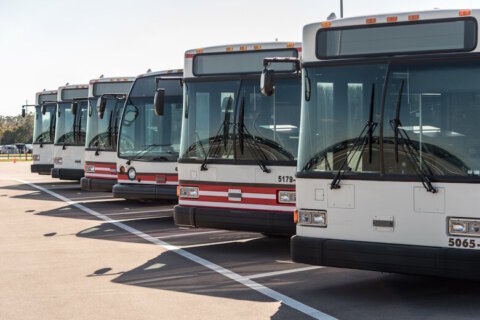This article was republished with permission from WTOP’s news partners at Maryland Matters. Sign up for Maryland Matters’ free email subscription today.
This content was republished with permission from WTOP’s news partners at Maryland Matters. Sign up for Maryland Matters’ free email subscription today.
Citing concerns about a lack of diversity in the slate of nominees selected for the Blueprint for Maryland’s Future’s accountability board, Gov. Lawrence J. Hogan Jr. (R) took the unusual step on Friday of asking the nominating committee to provide him a new slate that “accurately reflect[s] our student population.”
“While many of the nominees selected are undoubtedly qualified individuals, there is a discernible lack of representation from the majority of jurisdictions in the State,” Hogan wrote in his letter addressed the nominating committee Friday morning.
The Accountability and Implementation Board (AIB) was established through the Blueprint for Maryland’s Future, a multi-billion-dollar education reform plan intended to close student achievement gaps and transform the state’s education system over the next decade.
Hogan wrote that he received a letter from Prince George’s County Executive Angela Alsobrooks (D) expressing concerns about the lack of representation for Prince George’s County, the second-largest jurisdiction in the state. There is also no representation from the Eastern Shore, Western Maryland or any rural jurisdiction, he continued.
Out of the slate of nominees sent to the governor last week, four reside in Montgomery County, three in Baltimore City, one in Baltimore County and one in Anne Arundel County.
Hogan’s letter also comes after the Maryland Legislative Latino Caucus sent a letter to the governor last week, expressing their disappointment with the lack of representation for Latino communities among the nominees selected.
The slate of nominees that the nominating committee sent to Hogan last week consists of four people who identify as white, four as Black and one as Asian.
“The legislation and the Board may be intended to help all Marylanders, however, there is a discernible lack of representation for Latino communities in Maryland. We know if we are not at the table, we are less likely to have a voice,” Del. David Fraser-Hidalgo (D-Montgomery), the chair of the Latino Caucus, wrote in the letter.
Fraser-Hidalgo noted that the Latino population grew from 8% to 12% in Maryland over the last decade, according to the recently released 2020 census data.
Latino youth also make up the largest proportion of English language learners and often experience disproportionate levels of poverty, so they especially have most to gain from the Blueprint education reforms, Fraser-Hidalgo continued. “Without adequate representation on the AIB, it will be difficult to sufficiently meet the needs of Latino students whom this legislation is intended to support,” he wrote.
Fraser-Hidalgo urged Hogan to name “a qualified Latino member” to the AIB.
“I thank the Governor for making sure that every student and jurisdiction is represented,” said Del. Joseline A. Peña-Melnyk (D-Prince George’s and Anne Arundel).
Education advocacy groups also decried the lack of representation in the slate of nominees.
“Unfortunately, there are some significant oversights in the composition of the nominees. The lack of representation from Prince George’s County, the second largest school district in the state with a student population that is more than 90% Black and Latino, is a glaring omission,” the Maryland Alliance for Racial Equity in Education, a coalition of education and civil rights advocates, wrote in a statement. “Even more concerning is the lack of Latino representation, the fastest growing population and a student population of 110,529 in Maryland.”
Shanaysha Sauls, the chair of the nominating committee, said that the primary role of the AIB is not about representing local jurisdictions. “There’s nothing about the responsibilities of the Accountability and Implementation Board that would suggest that by having someone from a jurisdiction, that jurisdiction gets special consideration or is less or more accountable than any other jurisdiction,” she said.
According to the Blueprint, the AIB nominating committee must select nominees that “reflect, to the extent practicable, the geographic, racial, ethnic, cultural, and gender diversity of the state” with high expertise in education.
The primary responsibility of the seven-member Accountability and Implementation Board is oversight of state and local entities as they implement Blueprint policies, which include expanding pre-kindergarten programs, increasing funding for schools with higher concentrations of poverty, boosting pay and career opportunities for teachers and providing more individualized instruction. For the next decade, the AIB will evaluate the results of Blueprint reforms against their intended outcomes.
Out of the 43 applicants that the nominating committee received, only two identified as Latinx and three were from Prince George’s County, according to the committee.
Sauls said racial diversity was only one marker of many that the nominating committee considered when selecting nominees. Committee members also considered applicants’ experience in working in school districts with diverse populations or have a high concentration of poverty. They also looked at generational diversity.
“We were trying to strike the right balance of composition of people with a high-level of experience in policy or practice, not only in terms of race and gender, but also in generation,” she said. “How you experience and understand racial disparities and changes in public education do matter based on your generation, and we have a mix of people who are millennials, Gen-Xers and Boomers among the nominees.”
When the committee reviewed the applications from those who resided in Prince George’s County or identified as Latinx and compared this racial or geographical identity with their other credentials, “we just had to make some hard choices,” Sauls said.
However, it is important to note that one nominee has worked at Prince George’s Community College for 29 years and two others have worked at the University of Maryland, College Park, which is also in Prince George’s County. “I think that can’t be understated,” Sauls said.
In Friday’s letter to the nominating committee, Hogan wrote “in light of this lack of diversity, which has drawn bipartisan concern, I am hereby requesting that you immediately reopen the application process and provide a slate of nominees that accurately reflect our student population.”
Hogan has until Oct. 1 to appoint seven of the nine candidates, who are also subject to Senate confirmation. In his letter, Hogan asked for a new slate of nominees by Sept. 27.
He also included that there was a “troubling lack of transparency” in the nominee selection process, in which “the public could not provide meaningful input or hear the deliberations” in closed sessions. The nominating committee met publicly in early July to go over their tasks, held four closed meetings in August and held a public meeting in September to announce the slate of nominees.
Members of the nominating committee have said that most of their meetings were closed to protect applicants’ privacy, as the committee largely deals with personnel matters.
However, it is unclear whether Hogan has the authority to make such a move. According to Rachel Hise, a policy analyst from the Department of Legislative Services, the list of nine nominees is final and the Governor must choose seven from that list.
If there are vacancies in the future, the committee must put forward two names for each vacancy, and the Governor must choose one from that list, she continued.
Although important to include racial and geographical representation, I’m concerned that this is going to set us back. I see there being benefits to making this gesture, but I don’t think that the law allows for this,” said Shamoyia Gardiner, executive director of Strong Schools Maryland, a grassroots organization advocating for the Blueprint.
Sen. Paul Pinsky (D-Prince George’s), the vice chair of the nominating committee and chair of the Senate Education, Health and Environmental Affairs Committee, said that the three years that the Kirwan Commission met to develop policies for the Blueprint was a critical time to have all voices and stakeholders at the table.
But the main responsibility of the AIB is to hold all 24 jurisdictions accountable, not to have geographical and racial representation, he continued. “We don’t just recruit people to check boxes,” he said.
“We have to be very clear with what the responsibility for the legislature and the Kirwan commission that developed the [Blueprint] policies was on one hand and what the responsibilities for the AIB is on the other,” Pinsky said.
“I don’t think any of the six of us are so rigid that we won’t consider some of the reactions,” Pinsky continued. But he could not say for certain Friday afternoon whether the committee would send more nominees to the governor.







